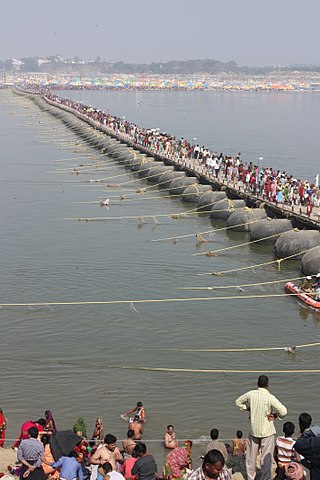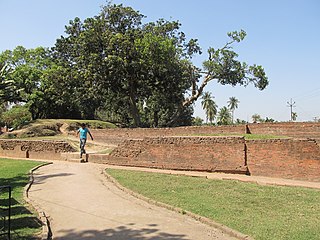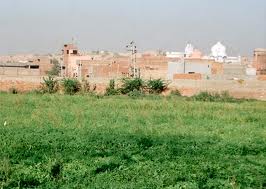The Chalcolithic is an archaeological period characterized by the increasing use of smelted copper. It follows the Neolithic and precedes the Bronze Age. It occurs at different periods in different areas, and is absent in some parts of the world, such as Russia. Stone tools were still predominantly used during this period.

Kumbh Mela or Kumbha Mela is a major pilgrimage and festival in Hinduism. It is celebrated in a cycle of approximately 12 years, to celebrate every revolution Brihaspati (Jupiter) completes, at four river-bank pilgrimage sites: Prayagraj, Haridwar (Ganges), Nashik (Godavari), and Ujjain (Shipra). The festival is marked by a ritual dip in the waters, but it is also a celebration of community commerce with numerous fairs, education, religious discourses by saints, mass gatherings of monks, and entertainment. The seekers believe that bathing in these rivers is a means to prāyaścitta for past mistakes, and that it cleanses them of their sins.
Paithan ['pəɪ.ʈʰaɳ], historically Pratiṣṭhāna [pɾə'tɪʂʈʰana], is a town with municipal council in Aurangabad district, Maharashtra, Maharashtra, India. Paithan is located 56 kilometres (35 mi) south of present-day Aurangabad on the Godavari River. It was the capital of the Satavahana dynasty, which ruled from the second century BCE to the second century CE. It is one of the few inland towns mentioned in the famous first-century Greek book, the Periplus of the Erythraean Sea.

Urvashi is the most prominent apsara mentioned in the Hindu scriptures like the Vedas, the epics Ramayana and Mahabharata, as well as the Puranas. She is regarded as the most beautiful of all the apsaras, and an expert dancer.

Chandraketugarh is a 2,500 years old archaeological site located near the Bidyadhari river, about 35 kilometres (22 mi) north-east of Kolkata, India, in the district of North 24 parganas, near the township of Berachampa and the Harua Road railhead. Once it was an important hub of international maritime trade. A museum has been built near the site depicting largely collections of Dilip Kumar Maity, a retired school teacher and amateur archaeologist.

Rupnagar district is one of twenty-two districts in the state of Punjab, India. The city of Rupnagar is said to have been founded by a Raja called Rokeshar, who ruled during the 11th century and named it after his son Rup Sen. It is also the site of an ancient town of the Indus Valley civilization. The major cities in Rupnagar District are Morinda, Nangal and Anandpur Sahib. Morinda is also known as Baghwāla "[The City] of Gardens." Morinda is located on the Chandigarh-Ludhiana Highway. The Bhakra Dam in Nangal lies on the boundary with the neighboring state of Himachal Pradesh. Dadhi is one of the most important villages of the district, particularly because of Gurudwara Sri Hargobindsar Sahib.
Jhusi or Jhunsi is a town in Prayagraj district in the Indian state of Uttar Pradesh. It was formerly called Pratishthan Pur or Puri.

Vikramōrvaśīyam is a five-act Sanskrit play by ancient Indian poet Kālidāsa, who lived in the 4th or 5th Century CE, on the Vedic love story of King Pururavas and an Apsarā named Ūrvaśī, known for her beauty.

Pottery in the Indian subcontinent has an ancient history and is one of the most tangible and iconic elements of Indian art. Evidence of pottery has been found in the early settlements of Lahuradewa and later the Indus Valley Civilisation. Today, it is a cultural art that is still practiced extensively in Indian subcontinent. Until recent times all Indian pottery has been earthenware, including terracotta.

Prayagraj, initially named Ilahabad or Allahabad in an anglicized version in Roman script, and anciently Prayag, is a city situated on an inland peninsula, surrounded by the rivers Ganges and Yamuna on three sides, with only one side connected to the mainland Doab region, of which it is a part. This position is of importance in Hindu scriptures for it is situated at the confluence, known as Triveni Sangam, of the holy rivers. As per Rigveda the Sarasvati River was part of the three river confluence in ancient times. It is one of four sites of the Kumbh Mela, an important mass Hindu pilgrimage.

Teppe Zagheh is an early urban settlement located near Qazvin, Iran. In Persian, Tappeh means "tell, mound". It was first excavated by a team from the University of Tehran under the direction of Ezzat Negahban in the early 1970s
Gilund is a village and an archaeological site located in Rajsamand district of Rajasthan state in western India. It is one of five ancient sites excavated in the Ahar-Banas Complex which also includes the sites of Ahar, Ojiyana, Marmi, and Balathal. Out of the 111 reported sites found in the Ahar-Banas Complex, Gilund is the largest. The archaeological site was named after the present-day village, Gilund, and is locally known as Modiya Magari which means "bald habitation mound".
Mitathal is a village and Indus Valley civilization (IVC) Archaeological sites in the Bhiwani tehsil of the Bhiwani district in the Indian state of Haryana. Part of Hisar division, it lies 12 kilometres (7.5 mi) north of the district headquarters Bhiwani and 249 kilometres (155 mi) from the state capital Chandigarh. As of the 2011 Census of India, the village had 1,448 households with a total population of 7,434 of which 4,002 were male and 3,432 female.

Agroha, locally known as Ther, is an archaeological site located in Agroha, in the Hisar district of India.

Pundranagar in Paundrabhukti was the most important city in the ancient Bengal region, now identified with the current site of Mahasthan, located in Bogra, Bangladesh. It was a vibrant administrative, religious and cultural centre from the 3rd century BC to the 12th century AD that is from the Maurya Empire time to the Sena dynasty period. Archaeological remains and literary descriptions speak of a truly planned and magnificent city. City walls, elaborate gates, palaces, common dwellings, assembly halls, temples, viharas, shops, ponds and even suburban temples and viharas characterised the city; Chinese pilgrim, Xuanzang, visiting in the 7th century AD, particularly mentions ponds, orchards, flowers and pleasure gardens.

Kapilavastu Museum is a cultural and religious museum in Tilaurakot, Nepal. Kapilavastu is the ancient city of the Sakyas, Sakyamuni Buddha son of Suddhodhan. There are more than 136 archaeological sites in the territory of ancient Kapilavastu. Tilaurākoṭ, Niglihawa, Gotihawa, Arorakot, Sisahaniyakot, Chhetradehi, Sagrahawa, Pipari etc. are enriched with ancient art remains and monuments. Archaeological findings of Tilaurākoṭ and of other sites are kept in Kapilavastu museum.
Chirand is an archaeological site in the Saran district of Bihar, India, situated on the northern bank of the Ganga River. It has a large pre-historic mound which is known for its continuous archaeological record from the Neolithic age to the reign of the Pal dynasty who ruled during the pre-medieval period. The excavations in Chirand have revealed stratified Neolithic, Chalcolithic, and Iron Age settlements, and transitions in human habitation patterns dating from 2500 BC to 30 AD.

Srughna, also spelt Shrughna in Sanskrit, or Sughna, Sughana or Sugh in the spoken form, was an ancient city or kingdom of India frequently referred to in early and medieval texts. It was visited by Chinese traveller, Xuanzang in the 7th century and was reported to be in ruins even then although the foundations still remained. Xuanzang described the kingdom as extending from the mountains to the north, to the Ganges river to the East, and with the Yamuna river flowing through it. He described the capital city on the west bank of the Yamuna as possessing a large Buddhist vihara and a grand stupa dating to the time of the Mauryan emperor, Ashoka. Srughna is identified with the Sugh Ancient Mound located in the village of Amadalpur Dayalgarh, in the Yamunanagar district of Haryana state of India. To this day, the ancient Chaneti Buddhist Stupa, probably dating to the Mauryan period, stands in the area, about 3 kilometres (1.9 mi) northwest of Sugh.
Saridkel is an ancient site located in the khunti district of Jharkhand. There are ancient ruins of burnt brick houses found on the site along with redware pottery, copper tools, coins, gold earrings and iron tools. Well fortified buildings suggest that it was probably a royal house or Monastery belonging to the 1st or 2nd century CE, according to the archeological department.












